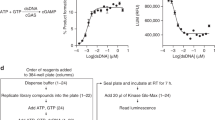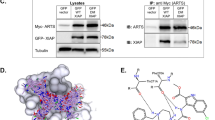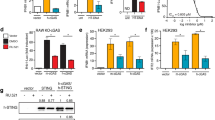Abstract
Cellular inhibitor of apoptosis proteins 1 and 2 (c-IAP1/2) have central roles in signal transduction mediated by numerous receptors that participate in inflammatory and immune responses. In certain pathways, such as activation of NF-κB, their degradation is a major regulatory event and is physiologically induced by activation of receptors. In addition, a number of synthetic compounds have been developed that also target the c-IAPs and induce their degradation. However, the extent of a synthetic IAP antagonist’s ability to mirror the transcriptional program by a physiological signal remains unclear. Here we take a systems approach to compare the transcriptional programs triggered by activation of CD30, a well-characterized receptor previously shown to induce the degradation of the c-IAPs, to SM-164, a synthetic IAP antagonist that specifically triggers c-IAP degradation. Employing a technique that allows the specific analysis of newly transcribed RNA, we have generated comparative transcriptome profiles for CD30 activation and SM-164 treatment. Analysis of these profiles revealed that the genes regulated by each stimulus were not completely shared, indicating novel functions of IAP antagonists and consequences of c-IAP1/2 degradation. The data identified a role for c-IAP1/2 in the regulation of the ribosome and protein synthesis, which was subsequently confirmed by biological assays. These findings expand our knowledge of the roles of c-IAP1/2 in signaling and provide insight into the mechanism of synthetic IAP antagonists, furthering our understanding of their therapeutic potential.
This is a preview of subscription content, access via your institution
Access options
Subscribe to this journal
Receive 50 print issues and online access
$259.00 per year
only $5.18 per issue
Buy this article
- Purchase on Springer Link
- Instant access to full article PDF
Prices may be subject to local taxes which are calculated during checkout





Similar content being viewed by others
References
Salvesen GS, Duckett CS . IAP proteins: blocking the road to death's door. Nat Rev Mol Cell Biol 2002; 3: 401–410.
Hayden MS, Ghosh S . Shared principles in NF-κB signaling. Cell 2008; 132: 344–362.
Smale ST . Dimer-specific regulatory mechanisms within the NF-κB family of transcription factors. Immunol Rev 2012; 246: 193–204.
Vallabhapurapu S, Karin M . Regulation and function of NF-κB transcription factors in the immune system. Annu Rev Immunol 2009; 27: 693–733.
DiDonato JA, Mercurio F, Karin M . NF-κB and the link between inflammation and cancer. Immunol Rev 2012; 246: 379–400.
Perkins ND . The diverse and complex roles of NF-κB subunits in cancer. Nat Rev Cancer 2012; 12: 121–132.
Hacker H, Tseng PH, Karin M . Expanding TRAF function: TRAF3 as a tri-faced immune regulator. Nat Rev Immunol 2011; 11: 457–468.
Wright CW, Rumble JM, Duckett CS . CD30 activates both the canonical and alternative NF-κB pathways in anaplastic large cell lymphoma cells. J Biol Chem 2007; 282: 10252–10262.
Wright CW, Duckett CS . The aryl hydrocarbon nuclear translocator alters CD30-mediated NF-κB-dependent transcription. Science 2009; 323: 251–255.
Vallabhapurapu S, Matsuzawa A, Zhang W, Tseng PH, Keats JJ, Wang H et al. Nonredundant and complementary functions of TRAF2 and TRAF3 in a ubiquitination cascade that activates NIK-dependent alternative NF-κB signaling. Nat Immunol 2008; 9: 1364–1370.
Csomos RA, Wright CW, Galban S, Oetjen KA, Duckett CS . Two distinct signalling cascades target the NF-κB regulatory factor c-IAP1 for degradation. Biochem J 2009; 420: 83–91.
Varfolomeev E, Blankenship JW, Wayson SM, Fedorova AV, Kayagaki N, Garg P et al. IAP antagonists induce autoubiquitination of c-IAPs, NF-κB activation, and TNFα-dependent apoptosis. Cell 2007; 131: 669–681.
Vince JE, Wong WW, Khan N, Feltham R, Chau D, Ahmed AU et al. IAP antagonists target cIAP1 to induce TNFα-dependent apoptosis. Cell 2007; 131: 682–693.
Lu J, Bai L, Sun H, Nikolovska-Coleska Z, McEachern D, Qiu S et al. SM-164: a novel, bivalent Smac mimetic that induces apoptosis and tumor regression by concurrent removal of the blockade of cIAP-1/2 and XIAP. Cancer Res 2008; 68: 9384–9393.
Darding M, Feltham R, Tenev T, Bianchi K, Benetatos C, Silke J et al. Molecular determinants of Smac mimetic induced degradation of cIAP1 and cIAP2. Cell Death Differ 2011; 18: 1376–1386.
Chiarle R, Podda A, Prolla G, Gong J, Thorbecke GJ, Inghirami G . CD30 in normal and neoplastic cells. Clin Immunol 1999; 90: 157–164.
Mir SS, Richter BW, Duckett CS . Differential effects of CD30 activation in anaplastic large cell lymphoma and Hodgkin disease cells. Blood 2000; 96: 4307–4312.
Tian ZG, Longo DL, Funakoshi S, Asai O, Ferris DK, Widmer M et al. In vivo antitumor effects of unconjugated CD30 monoclonal antibodies on human anaplastic large-cell lymphoma xenografts. Cancer Res 1995; 55: 5335–53341.
Silke J . The regulation of TNF signalling: what a tangled web we weave. Curr Opin Immunol 2011; 23: 620–626.
Paulsen MT, Veloso A, Prasad J, Bedi K, Ljungman EA, Tsan YC et al. Coordinated regulation of synthesis and stability of RNA during the acute TNF-induced proinflammatory response. Proc Natl Acad Sci USA 2013; 110: 2240–2245.
Paulsen MT, Veloso A, Prasad J, Bedi K, Ljungman EA, Magnuson B et al. Use of Bru-Seq and BruChase-Seq for genome-wide assessment of the synthesis and stability of RNA. Methods 2014; 67: 45–54.
Kenneth NS, Hucks GEJ, Kocab AJ, McCollom AL, Duckett CS . Copper is a potent inhibitor of both the canonical and non-canonical NF-κB pathways. Cell Cycle. 2014; 13: 1006–1014.
Subramanian A, Tamayo P, Mootha VK, Mukherjee S, Ebert BL, Gillette MA et al. Gene set enrichment analysis: a knowledge-based approach for interpreting genome-wide expression profiles. Proc Natl Acad Sci USA 2005; 102: 15545–15550.
Signer RA, Magee JA, Salic A, Morrison SJ . Haematopoietic stem cells require a highly regulated protein synthesis rate. Nature 2014; 509: 49–54.
Zhang J, Wang J, Ng S, Lin Q, Shen HM . Development of a novel method for quantification of autophagic protein degradation by AHA labeling. Autophagy 2014; 10: 901–912.
Vandenabeele P, Galluzzi L, Vanden Berghe T, Kroemer G . Molecular mechanisms of necroptosis: an ordered cellular explosion. Nat Rev Mol Cell Biol 2010; 11: 700–714.
Darding M, Meier P . IAPs: guardians of RIPK1. Cell Death Differ 2012; 19: 58–66.
Oeckinghaus A, Hayden MS, Ghosh S . Crosstalk in NF-κB signaling pathways. Nat Immunol 2011; 12: 695–708.
Buchan SL, Al-Shamkhani A . Distinct motifs in the intracellular domain of human CD30 differentially activate canonical and alternative transcription factor NF-κB signaling. PLoS ONE 2012; 7: e45244.
Ruggero D, Pandolfi PP . Does the ribosome translate cancer? Nat Rev Cancer 2003; 3: 179–192.
Matsuzawa A, Tseng PH, Vallabhapurapu S, Luo JL, Zhang W, Wang H et al. Essential cytoplasmic translocation of a cytokine receptor-assembled signaling complex. Science 2008; 321: 663–668.
Duckett CS, Gedrich RW, Gilfillan MC, Thompson CB . Induction of Nuclear Factor κB by the CD30 Receptor is Mediated by TRAF1 and TRAF2. Mol Cell Biol 1997; 17: 1535–1542.
Malinin NL, Boldin MP, Kovalenko AV, Wallach D . MAP3K-related kinase involved in NF-κB induction by TNF, CD95, and IL-1. Nature 1997; 385: 540–544.
Zarnegar B, Yamazaki S, He JQ, Cheng G . Control of canonical NF-κB activation through the NIK-IKK complex pathway. Proc Natl Acad Sci USA 2008; 105: 3503–3508.
Duckett CS, Thompson CB . CD30-dependent degradation of TRAF2: implications for negative regulation of TRAF signaling and the control of cell survival. Genes Dev 1997; 11: 2810–2821.
Sun H, Nikolovska-Coleska Z, Lu J, Meagher JL, Yang CY, Qiu S et al. Design, synthesis, and characterization of a potent, nonpeptide, cell-permeable, bivalent Smac mimetic that concurrently targets both the BIR2 and BIR3 domains in XIAP. J Am Chem Soc 2007; 129: 15279–15294.
Galban S, Duckett CS . XIAP as a ubiquitin ligase in cellular signaling. Cell Death Differ 2010; 17: 54–60.
Kenneth NS, Duckett CS . IAP proteins: regulators of cell migration and development. Curr Opin Cell Biol 2012; 24: 871–875.
Acknowledgements
We thank Drs Shaomeng Wang (University of Michigan, Ann Arbor, MI, USA) for the kind gift of SM-164, Judith Sebolt-Leopold (University of Michigan) for the gift of Trametinib, Niall Kenneth (Newcastle University, Newcastle upon Tyne, UK) for his insightful suggestions, Elizabeth Lawlor (University of Michigan, Ann Arbor, MI, USA) for her critical reading of the manuscript, Thomas Wilson (University of Michigan, Ann Arbor, MI, USA) for use of his data analysis software, the members of the Duckett laboratory for their helpful advice and the personnel at the University of Michigan Molecular and Behavioral Neuroscience Institute computing cluster and the University of Michigan Sequencing Core for their technical assistance. This work was supported in part by NIH R01CA142809 (to CSD), NIH 1R01HG006786 (to ML) and NIH T32AI007413 (to AJK).
Author Contributions
AJK and CSD designed the research. AJK and MTP performed the research. AJK, AV, ML and CSD analyzed the data. AJK and CSD wrote the manuscript.
Author information
Authors and Affiliations
Corresponding author
Ethics declarations
Competing interests
The authors declare no conflict of interest.
Additional information
Supplementary Information accompanies this paper on the Oncogene website
Rights and permissions
About this article
Cite this article
Kocab, A., Veloso, A., Paulsen, M. et al. Effects of physiological and synthetic IAP antagonism on c-IAP-dependent signaling. Oncogene 34, 5472–5481 (2015). https://doi.org/10.1038/onc.2015.3
Received:
Revised:
Accepted:
Published:
Issue Date:
DOI: https://doi.org/10.1038/onc.2015.3
This article is cited by
-
Comparative transcriptomic analysis of surf clams (Paphia undulate) infected with two strains of Vibrio spp. reveals the identity of key immune genes involved in host defense
BMC Genomics (2019)
-
Trichostatin A potentiates TRAIL-induced antitumor effects via inhibition of ERK/FOXM1 pathway in gastric cancer
Tumor Biology (2016)



